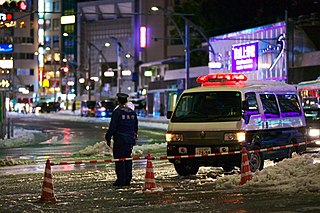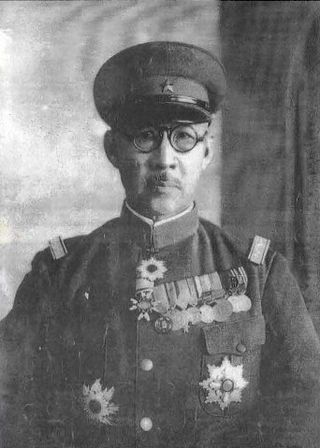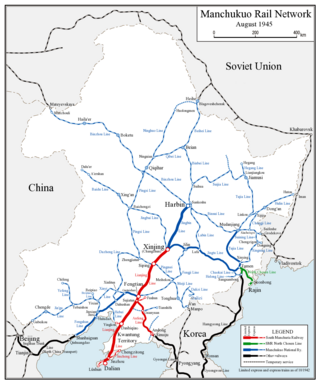
Manchukuo was a puppet state of the Empire of Japan in Northeast China that existed from 1932 until its dissolution in 1945. It was ostensibly founded as a republic, its territory consisting of the lands seized in the Japanese invasion of Manchuria; it was later declared to be a constitutional monarchy in 1934, though very little changed in the actual functioning of government. Manchukuo received limited diplomatic recognition, mostly from states aligned with the Axis powers, with its existence widely seen as illegitimate.

Changchun is the capital and largest city of Jilin Province in China. Lying in the center of the Songliao Plain, Changchun is administered as a sub-provincial city, comprising 7 districts, 1 county and 3 county-level cities. According to the 2020 census of China, Changchun had a total population of 9,066,906 under its jurisdiction. The city's metro area, comprising 5 districts and 1 development area, had a population of 5,019,477 in 2020, as the Shuangyang and Jiutai districts are not urbanized yet. It is one of the biggest cities in Northeast China, along with Shenyang, Dalian and Harbin.

The South Manchuria Railway, officially The South Manchuria Railway Company, Ltd., Mantetsu or Mantie for short, was a large National Policy Company of the Empire of Japan whose primary function was the operation of railways on the Dalian–Fengtian (Mukden)–Changchun corridor in northeastern China, as well as on several branch lines.

Taihoku Prefecture was an administrative division of Taiwan created in 1920, during Japanese rule. The prefecture consisted of modern-day Keelung, New Taipei City, Taipei and Yilan County. Its government office, which is now occupied by the Control Yuan of Taiwan, was in Taihoku City.

The National Police Agency is the central coordinating law enforcement agency of the Japanese police system. Unlike national police in other countries, the NPA does not have any operational units of its own aside from the Imperial Guard; rather, it is responsible for supervising Japan's 47 prefectural police departments and determining their general standards and policies, though it can command police agencies under it in national emergencies or large-scale disasters. It is under the National Public Safety Commission of the Cabinet Office.

Manchuria Aviation Company was the national airline of Manchukuo.
In Japan, the Imperial Guard is the name for two separate organizations dedicated to the protection of the Emperor of Japan and the Imperial Family, palaces and other imperial properties. The first was the Imperial guard divisions, a quasi-independent elite branch of the Imperial Japanese Army which was dissolved shortly after World War II. The second is the Imperial Guard Headquarters, a civilian law enforcement organization formed as part of the National Police Agency. (警察庁)

Law enforcement in Japan is provided mainly by prefectural police under the oversight of the National Police Agency. The National Police Agency is administered by the National Public Safety Commission, ensuring that Japan's police are an apolitical body and free of direct central government executive control. They are checked by an independent judiciary and monitored by a free and active press.

The Huanggutun incident, also known as the Zhang Zuolin Explosion Death Incident, was the assassination of the Fengtian warlord and Generalissimo of the Military Government of China Zhang Zuolin near Shenyang on 4 June 1928.

The Manchukuo Imperial Navy was the navy of the Japanese puppet state of Manchukuo.

The flag of the Empire of Manchuria had a yellow field with four horizontal stripes of different colours in the upper-left corner. The colours of the flag were based on the colours on the Five Races Under One Union flags used by the Beiyang government, the Empire of China, and by the Fengtian clique. The flag was first established in Announcement of National Flag on 1 March 1932.

The Manchukuo Imperial Air Force was the air force of Manchukuo, a puppet state of Imperial Japan. The air force's predecessor was the Manchukuo Air Transport Company, a paramilitary airline formed in 1931, which undertook transport and reconnaissance missions for the Japanese military.

The Asia Express was a super express passenger train operated by the South Manchuria Railway (Mantetsu) from 1934 until 1943. This limited express, which began operation in November 1934 and was Mantetsu's most iconic train, operated in Manchukuo between Dalian and Changchun, and was extended to Harbin in 1935.
The East Asian Games, also known as the Asian Development Games were multi-sport events organized by the Japan Association of Athletics Federations (JAAA). The games were meant to be a replacement to the cancelled 1938 Far Eastern Championship Games and 1940 Summer Olympics originally to be hosted by Japan, and also served as a propaganda tool for Japan.

Urzhin Garmaevich Garmaev was a White Army officer, lieutenant general of the Japanese controlled Manchukuo Imperial Army, headmaster of the Xing'an Military School.
The military ranks of Manchukuo were the military insignia used by the Manchukuo Imperial Army, the Manchukuo Imperial Navy, and the Manchukuo Imperial Air Force during its existence, from its founding in 1932 until the Soviet invasion in 1945.

Li Yuan was a politician of the Republic of China and later Manchukuo.

The Manchukuo National Railway was the state-owned national railway company of Manchukuo. Generally called the "國線", it was controlled by the Manchukuo Ministry of Transportation and had its lines primarily in the central and northern parts of the country. In local newspapers it was simply referred to as "國鉄". It was built, operated and managed by the South Manchuria Railway, a state-owned national railway company of the Empire of Japan, of which the Kwantung Army frequently intervened in its affairs.

The Renkyō Line was the primary trunk line of the South Manchuria Railway from 1907 to 1945. The 701.4 km (435.8 mi) line ran between Dalian (Dairen) and Changchun (Xinjing).

In the law enforcement system in Japan, prefectural police are prefecture-level law enforcement agencies responsible for policing, law enforcement, and public security within their respective prefectures of Japan. Although prefectural police are, in principle, regarded as municipal police, they are mostly under the central oversight and control of the National Police Agency.
















